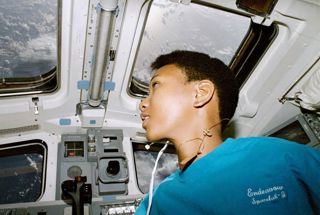
Black History Month: Mae Jemison
- 13th Oct 2021
- Author: Eleanor Morton
Early Life
Born on 17 October 1956 in Alabama, Mae Jemison knew from a young age she wanted to study. Her passion for space developed from watching the Apollo program. She often wished there were more women becoming astronauts. However, it wasn’t watching the Apollo missions that inspired Jemison to travel into space but Lieutenant Uhura in the TV show Star Trek, played by African-American actress Nichelle Nichols, that truly provided the spark.
By 1973, at the age of 16, Jemison was studying Chemical Engineering at Stamford University. One of the only black students in her classes, she experienced racial discrimination throughout her school career. She went on to choreograph a performing arts production called Out of the Shadows highlighting the African-American experience.
After graduating in 1977, Jemison attended Cornell Medical School where she trained as a doctor. During medical school, she led a study for the American Medical Student Association to Cuba and also worked in Thailand at a Cambodian refugee camp. Although a long way from space exploration, her medical school training aided countless experiments during her mission.
Space Shuttle Days
Once she achieved her doctorate, Jemison took a path more unusual in astronauts, and moved into general practice. In 1983 she joined the Peace Corps and served for two years as a medical officer in Sierra Leone and Liberia where she taught and practiced medical research. Once she was back in the US, Jemison began her own private practice, but her love of space was never too far from her mind.
In 1983 Sally Ride became the first American woman in space, flying on the Space Shuttle Challenger, which sparked Jemison’s dream of space travel all over again. In 1985 Jemison applied for the NASA space programme but, due to the Challenger disaster in 1986, NASA stopped taking on new astronauts. Jemison applied again in 1987 and was selected for NASA astronaut group 12, the first group chosen after the Challenge disaster.
After a year of training at NASA, Jemison was selected for her first mission on 28 September 1989 aboard STS-47. Three years later, on 12 September 1992, Jemison flew on her first mission on the Space Shuttle Endeavour. During that flight she became the first African-American woman in space.
Her role during the mission was to act as science mission specialist, a brand new role created by NASA to focus on experiments. She was responsible for the crew-related experiments performed on the shuttle and during the mission she performed a total of 44 experiments with her crew. On 20 September 1992, after 7 days and 22 hours in space, Jemison’s first and only space flight came to an end and they returned to Kennedy Space Center.
Life After NASA
After her spaceflight, Jemison retired from NASA in 1993 with the hope of starting her own company, the Jemison Group, which would encourage science, technology and social change. She would go on to teach at Dartmouth College, direct the Jemison Institute for Advancing Technology in Developing Countries, create an international space camp for students called The Earth We Share and the non-profit organisation the Dorothy Jemison Foundation for Excellence, all within 10 years of her retirement from NASA.
Perhaps one of Jemison’s personal career highlights was in 1993 when she was approached by the actor LeVar Burton after hearing she was a fan of the show Star Trek. Jemison became the first real astronaut to appear in the show Star Trek: The Next Generation where she played Lieutenant Palmer for one episode.
Throughout her career her focus has been on the promotion of science and technology for all people and is something she continues to this day. Now a published author of five books, and the inspiration for countless more, Jemison shares her life lessons with children everywhere.
Legacy
When describing Mae Jemison many refer to her simply as the first Black woman in space. Although correct, there is so much more to this extraordinary woman, who broke down barriers and inspired generations of young people to get into science.
She is an engineer, a doctor, an entrepreneur, an author and an astronaut. Not to mention a lieutenant on the Starship Enterprise. But more importantly she is an inspiration to young girls everywhere, showing just what you can do if you believe.
About the author: Eleanor Morton graduated from the University of Leicester with a Masters in Physics. She is an aspiring science writer and can be found on Twitter @ElMortonSci.







